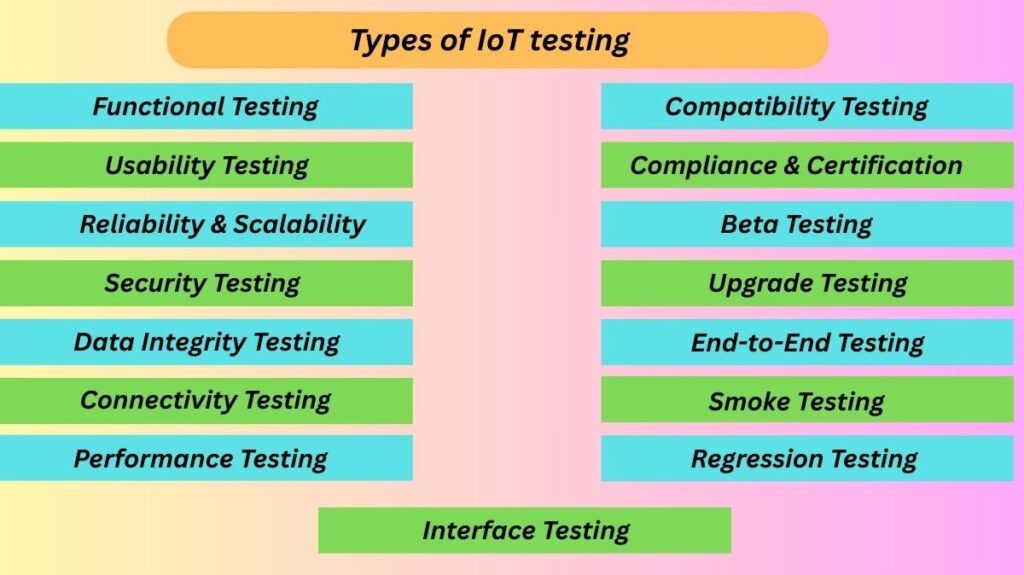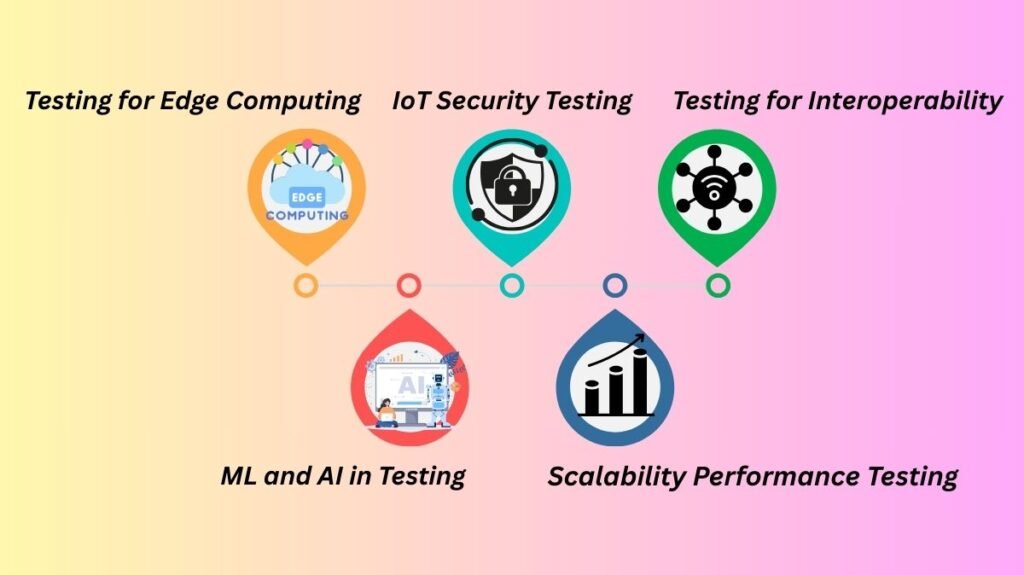What Are The Types of IoT testing?

Below, the many kinds of IoT testing are highlighted:
Functional Testing
This is to guarantee that the visiting work product communicates with other linked gadgets in the Internet of Things ecosystem. First, it consistently performs the function for which it was intended.
Usability Testing
Usability testing makes ensuring that the device’s and application’s interfaces satisfy user expectations and confirmations. The main goal of the tests is to confirm that the device or program can be used for some basic tasks, that it is responsive, that it protects nativity, that it can handle errors gracefully, and that it can be used without assistance or preparation.
Reliability and Scalability Testing
This entails making sure the Internet of Things system can expand efficiently and operates dependably in a range of network, operational, and environmental circumstances. This involves creating a reliable IoT test environment by emulating sensors with virtualisation techniques and technologies.
Security Testing
In its most basic form, security involves granting the protected device authorised access while restricting unauthorised access to its data. Threat modelling, static code analysis, and runtime check technologies are used to test the application and device by exposing them to a variety of simulated threats. Checks for the OWASP Top Ten Threats are also included in security tests.
Data Integrity Testing
Because of the large amount of data involved and its importance to the application, data integrity is essential in IoT testing.
Connectivity Testing
This testing involves putting the network through a load, intermittent failures, and complete loss of connectivity in order to examine how the device and application behave. The resilience and sturdiness of the device, edge, platform, and application are carefully assessed by creating these real-life scenarios.
Performance Testing
The cloud rate system’s performance under both normal and maximum load is measured by load generators. These tests evaluate how responsive the device is to user input. They assess the platform’s ability to adapt to traffic spikes in a polite manner. Metrics for evaluating the responsiveness of the application or device and the overall performance of the system have been supported.
Compatibility Testing
IoT devices should be tested on a variety of hardware platforms, operating systems, and dependent software versions in a complex IoT environment to make sure they function properly across browsers and platforms.
Compliance & Certification Testing
To enter the market, a thoroughly tested IoT product may also need the appropriate certification. Network, protocol compliance, device drivers, app store submissions, and other certification requirements are typically specific to IoT devices.
Beta (Pilot) Testing
The work product must be delivered in its target environment with all the variables to ascertain its behaviour after testing in a highly regulated and managed lab setting. Because the intended user verifies the work product for functionality, usability, stability, and compatibility, beta testing makes acceptance testing possible. Beta testing is not a regulated activity because it is done by end users.
Upgrade Testing
Incompatibilities can create failures when firmware, software, or hardware is updated, therefore regression testing is necessary. Before sending OTA updates to devices and server systems, specialised tests are often run in a highly staged environment. Updates, data protection, and a seamless system restart are essential after an upgrade.
End-to-End Testing
End-to-end testing simulates real-user interactions in an Internet of Things (IoT) context by thoroughly analysing the complete system. The way a normal user would navigate and use the IoT system from beginning to end is replicated by this testing technique.
Smoke Testing
Before moving on to more thorough testing methods, smoke testing is done to evaluate the IoT system’s stability. The overall stability and preparedness of the system and its constituent parts must be guaranteed due to the wide range of functions found in different IoT devices.
Regression Testing
Every time new modules are added, old devices are upgraded, or the IoT infrastructure is altered, regression testing is carried out. Modifications to device configurations or code may have an effect on how well the IoT system works as a whole. Regression testing is therefore essential to ensure that all system components continue to function as intended after any modifications.
Interface Testing
Validating the IoT system’s graphical user interface (GUI) is the main goal of interface testing. A graphical application is the main interface via which users may interact with and control the system, while device activities are carried out in the background. This round of testing makes that the GUI satisfies criteria and runs smoothly for users.
New Developments in IoT Testing

Testing for Edge Computing
Testing at the edge is becoming more and more important as edge computing grows. The development of test automation services is fuelled by the necessity to provide effective data processing without sacrificing performance.
IoT Security Testing
Security becomes critical as the number of connected devices increases. Security will be given top priority in future IoT testing, which will include integrated security protocols, vulnerability assessments, and compliance checks.
Testing for Interoperability
It is essential that devices communicate with each other seamlessly. With the use of automated testing for efficiency, interoperability testing guarantees that devices function well in a variety of ecosystems.
ML and AI in Testing
IoT devices are increasingly incorporating AI and ML. AI-driven tools for data analysis and problem prediction will be included into testing to improve productivity and proactive problem solving.
Scalability Performance Testing
Performance testing becomes essential as Internet of Things deployments grow in size. In order to properly evaluate scalability, automated tools will replicate real-world situations.
Secret to Improving Your IoT Testing Approach
There are a few things you can do to guarantee a seamless IoT testing procedure, even though you can run into a number of obstacles.
- Check the usability: Make sure the functionality of your Internet of Things solution meets user expectations by conducting real-world tests to learn how consumers interact with it.
- Assure interoperability and connectivity: Check for smooth communication between IoT devices and systems, particularly when there are brief outages.
- Take tests frequently and early: To find flaws quickly, start testing early in the development process and carry out tests often.
- Put security first: Use strong encryption and password systems to safeguard user interfaces and data exchange by incorporating them into functional testing.
- Conduct performance evaluations: To ensure responsiveness and dependability, test the platform’s scalability and stability under several workload scenarios.
- Make Use of Automation: For effective testing, particularly in big and intricate IoT systems, use automated tools.
- Encourage Cooperation: A good testing procedure is ensured by effective communication between all parties involved.

